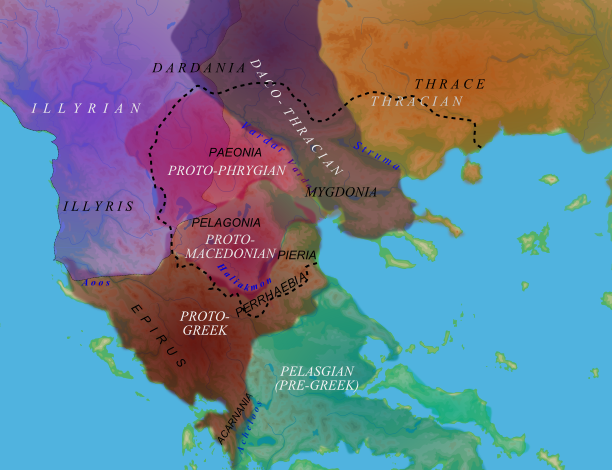Yes, the mention of Brygi within Illyrian lands by ancient authors proves that there were at the least two different language stratums within the territory of Albania. (Illyrian and Brygian).
If the Brygians were not from channeled ware but rather an older stratum (phrygian is close to greek, not a greek dialect though) that was pushed south and into anatolia during the channeled ware migrations,
then we may have to reckon with at least three different stratums of languages, the Illyrian, Brygian, and the Channelled Ware Thracoid language?
I remember an interesting argument by Aspar that the middle bronze age Brnjica culture was pushed by channeled ware more south in territories where Paeonians would later show up. Georgiev believed the Paeonian and Phrygian languages to be more closely related.
It is far more unclear than these propagandists who are trying to push their agendas are trying to make it out.
For example, they refer to the Taulanti name as being Albanian related, but this is literally where the channeled ware influence shows up in Albania, also where Brygians show up. So was this name from the Brygian or Channeled Ware influence or from the earlier stratum of J2b-l283 language people?
Likewise, they claim that I'm trying to push some sort of Kosova agenda, when I couldn't give less of a crap about this, they project their low intentions on to me, since that is how they operate and can't think beyond themselves.
Neither Nish or Shtip are in Kosova, I'm interested in finding the truth of which region the Albanian language came from, whereas they have the obsession to make sure it falls within the territory of Albania or Illyria by any means necessary (manipulation, lying, slander, etc).

In some areas into which Channelled Ware pushed, we have an interesting phenomenon: The (at that time) local Brnjica people moved up to the hills, built fortified hilltop settlements, whereas the incoming Channelled Ware people settled in the lowlands. We can also, very clearly, see that there were contacts between these two people, which lived in the EIA side by side. Like Channelled Ware pottery and goods being found in those hilltop forts.
The situation might have been similar to that of Vlachs/Albanians and Slavs. At first the Slavs rushed in, took the best parts of the country, but the locals had to relocate and adapt to a more hidden, better defensible position. However, in those very hilly areas, contrary to say the open lands along the Danube, the locals could persist and in theory its very hard to say who came out on top.
The logical conclusion, if we see in the pre-Illyrian people of the region e.g. Brygi, Paeonians and Thracians side by side, is that that non-Thracians likely being those LBA locals which relocated to the hills, and which, in some areas, came out on top.
In any case we definitely deal with a lot of substrate and adstrate phenomenons in and around Albania, that much is very clear.
Like Illyrians in some parts of the Adriatic coast made tabula rase, same for Thracians in some areas along the Danube. But again in other areas, it was more complicated with mixtures on top of mixtures and pushing forth and back. The Dardanians for example are very clearly not the typical Illyrians at all, but a complex fusion of different people in which the Illyrian elite element just turned out dominant.
Compare these two maps:


It would make sense that the Brygi/Phrygians, if being closer to Greco-Armenian, would have R-Z2103. Therefore we had in and around the Dardanians three groups of significance:
- Thracians: E-V13
- Illyrians: J-L283
- Brygi: R-Z2103
Hypothetical, but can be tested.







